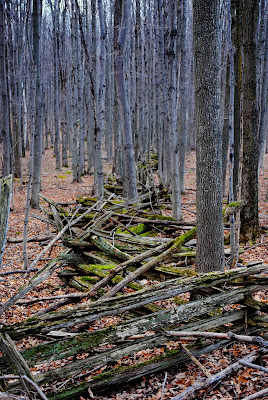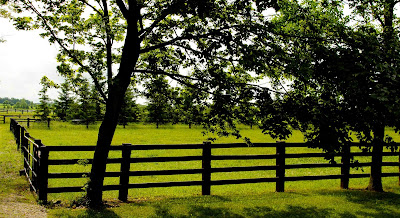You can't drive to see the first one, above. This is an old genuine snake cedar rail fence, probably one of the originals, built without fence posts, by criss-crossing the rails in a zig-zag pattern. As you can see, it's probably pretty old, because it implies the land on both sides was a field - today it's fairly mature sugar maple forest. Although there are thousands and thousands of old cedar rails lying on the ground out there where fences used to be, it's actually quite hard to find a fence like this still in place - though now serving no purpose other than being a bit of history.
Much more common are old cedar rail fences that have been rebuilt, often with pairs of vertical rails used as fence posts, and the rails wired in place in between them. And often starting to fall down where they're not maintained, like this, but still an attractive part of the rural landscape.
Next come the nicely rebuilt and maintained cedar rail fences, usually used for landscaping around rural homes. We have a short stretch of fence ourselves, just because it looks nice. Rails themselves are getting valuable; gathered up from old field edges where they're lying on the ground, they'll bring $3.00 each now. I even saw one fence recently that was made of NEW cedar rails - that means they cut the trees and split the rails, a skill almost universally long lost.
Most more recent fences are the standard fencepost and page wire or barbed wire. This one is a combination, and seems to be kept up by just adding fenceposts every 2-3 feet. I expect some of the posts aren't even sunk in the ground, but just replace the verticals of normal page wire fencing.
And finally there are the fences on horse farms. These are almost always the nicest and best maintained fences, designed with boards, or at least one wide band at the top, to make sure that running horses see the fence and don't injure themselves on the wires.
Next time perhaps I'll dig out some of the old stone fence pictures.
Linking to Friday Fences here:






Love the old fences!
ReplyDeleteI like all these shots of fences, but it would be especially exciting to come upon the old snake cedar rail ones.
ReplyDeleteI'm glad at least of couple of you commented on the old fences. I was really pleased with this one ranging from 150+/- years ago to now.
ReplyDeleteA great selection of rural fences. I am familiar with some of them being a country girl most of my life.
ReplyDeleteThe snake cedar rails, even on the ground, look so lovely with all that moss growing on them. All the different positions of the cedar rails in the second photo are quite enchanting! Enjoyed this post highlighting a history in rural fences.
ReplyDeleteLove the older fences...they tell a story, I like that!!!
ReplyDeleteThank you all for visiting. I enjoy weaving the pictures into a story if I can. Glad you enjoyed them.
ReplyDeleteExtremely informative blog post with superb pictures. I love to see this blog post this article really very valuable and knowledgeable for rural fencing solutions. Thanks for sharing this blog post with us.
ReplyDeleteIt is created by overlapping the ends of split rails. Rail and post length can be made to fit your needs. Stack rail or snake rail fencing, as some folks know it is made from hand split rails. privacy fence styles
ReplyDelete